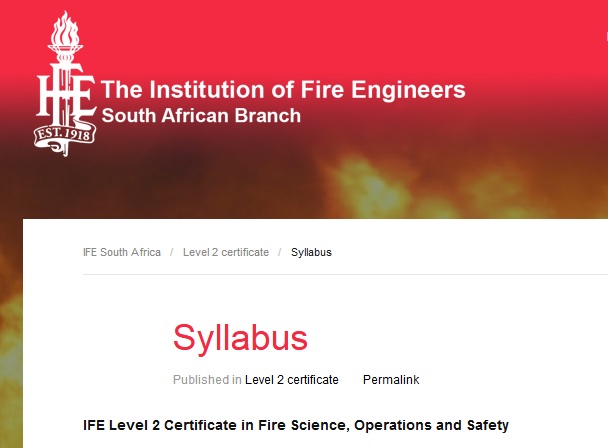IFE Level 2 Certificate Examination Syllabus : Institution of Fire Engineers
Organization : IFE – The Institution of Fire Engineers
Examination : IFE Level 2 Certificate Examination
Announcement : Syllabus
Subject : Fire Science,Operations and Safety
| Want to comment on this post? Go to bottom of this page. |
|---|
Website : http://www.ife.org.za/syllabus-l2c/
Download Syllabus : https://www.southafricain.com/uploads/7058-Level2Certificate.pdf
IFE Level 2 Certificate Examination Syllabus
Unit 1: Fire Science, Operations and Fire Safety
Section 1: Fire Engineering Science
Related : IFE Level 3 Certificate Examination Syllabus : www.southafricain.com/7072.html
Mathematics
| Assessment Objective | Knowledge, Understanding and Skills |
|
1.1 Carry out calculations to determine the area, volume and capacity of various shapes
|
Shapes including: square, triangle, rectangle, trapezium, rhombus, circle, cylinder, cube, irregularly shaped objects How to calculate area, volume, capacity Units of measurement for different purposes Presentation of calculations
|
|
1.2 Calculate the capacity of hose and/or pipelines
|
How to calculate capacity |

Physical Properties of Matter
| Assessment Objective | Knowledge, Understanding and Skills |
|
2.1 Define, understand and use terms
|
Mass Density Vapour density Liquids of different density Gases of different density Matter and energy Melting point, boiling point and evaporation |
3. Mechanics :
| Assessment Objective | Knowledge, Understanding and Skills |
|
3.1 Define and understand basic terms and be able to carry out basic calculations involving physical mechanics
|
Energy Force Friction Gravity Mass Momentum Motion Power Pressure Velocity Weight Work |
Fire and Rescue Operations
Section 2: :
1. Pre-Planning and Incident Command :
| Assessment Objective | Knowledge, Understanding and Skills |
| 1.1 Understand the value of pre-planning for incidents |
Significance of topography The safety of emergency and non-emergency personnel Safety with regard to environmental impact The nature of premises and processes Water supplies Liaison with key site personnel Other external partners/stakeholders
|
| 1.2 Understand the stages involved in an incident and the activities undertaken |
Initial assessment of an incident Development Closing stage Post-incident activities including debriefing
|
| 1.3 Understand the incident command system |
The impact of health and safety on the incident ground Definitions relating to incident command Incident command structure Lines of command Span of control Shared responsibility and authority – roles in the incident command system Sectorisation of incidents Use of cordons Levels of control: strategic, tactical, operational |
2. Fire and Rescue Procedures :
| Assessment Objective | Knowledge, Understanding and Skills |
| 2.1 Understand the basic principles involved in evacuating and searching for casualties |
Basic methods of search Basic methods of rescue Equipment and processes used in rescue Rescue of casualties Evacuation
|
| 2.2 Demonstrate a basic knowledge of how to tackle incidents in different situations |
Chimney fires One room fires Duct fires Roof fires Basement and underground fires High rise building fires
|
| 2.3 Understand the basic principles and procedures for tactical firefighting interventions |
Action to be taken on initial entry Working in smoke, heat or darkness Identifying risks including explosion risks, signs of building collapse, hazardous materials Evacuation procedures Establishing bridgehead |